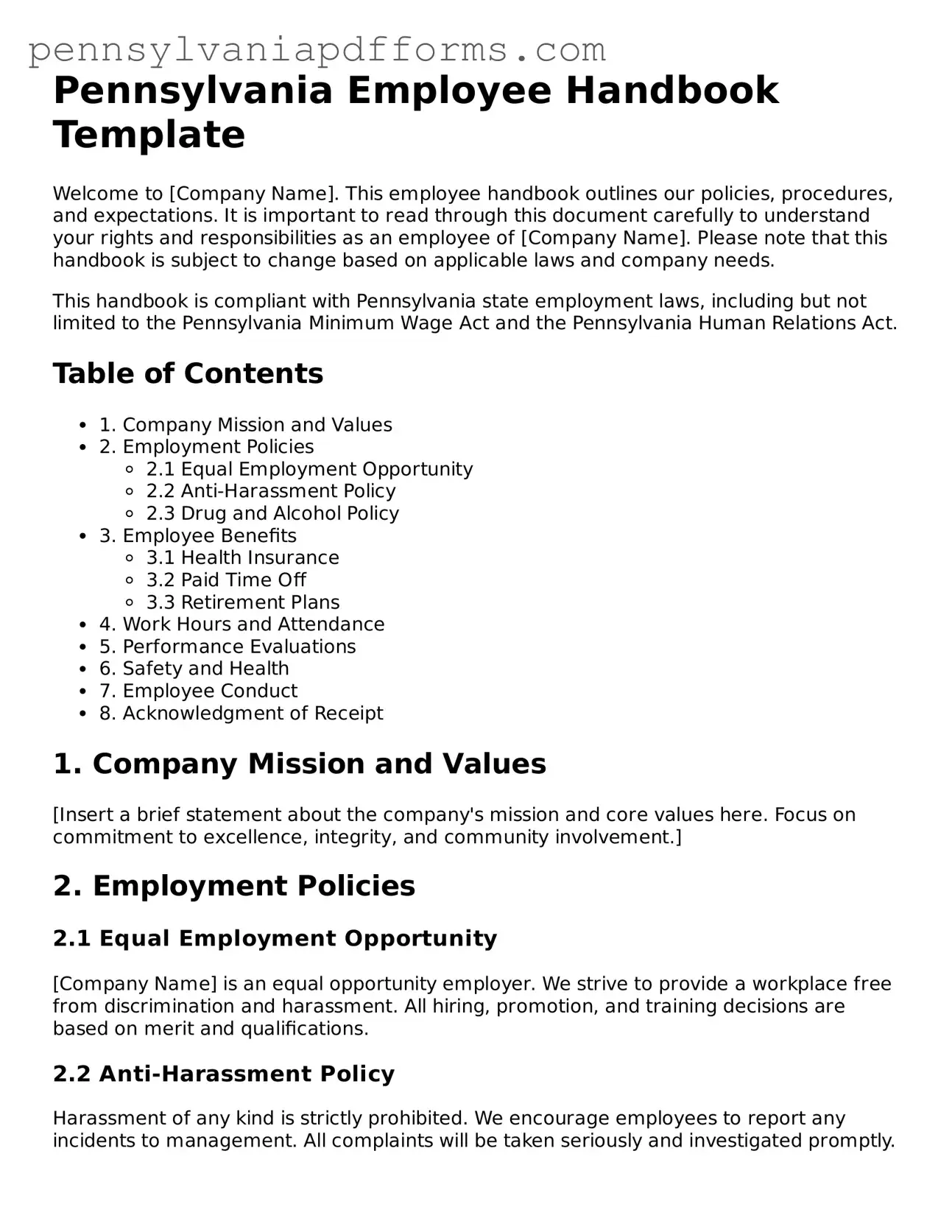Pennsylvania Employee Handbook Template
Welcome to [Company Name]. This employee handbook outlines our policies, procedures, and expectations. It is important to read through this document carefully to understand your rights and responsibilities as an employee of [Company Name]. Please note that this handbook is subject to change based on applicable laws and company needs.
This handbook is compliant with Pennsylvania state employment laws, including but not limited to the Pennsylvania Minimum Wage Act and the Pennsylvania Human Relations Act.
Table of Contents
- 1. Company Mission and Values
- 2. Employment Policies
- 2.1 Equal Employment Opportunity
- 2.2 Anti-Harassment Policy
- 2.3 Drug and Alcohol Policy
- 3. Employee Benefits
- 3.1 Health Insurance
- 3.2 Paid Time Off
- 3.3 Retirement Plans
- 4. Work Hours and Attendance
- 5. Performance Evaluations
- 6. Safety and Health
- 7. Employee Conduct
- 8. Acknowledgment of Receipt
1. Company Mission and Values
[Insert a brief statement about the company's mission and core values here. Focus on commitment to excellence, integrity, and community involvement.]
2. Employment Policies
2.1 Equal Employment Opportunity
[Company Name] is an equal opportunity employer. We strive to provide a workplace free from discrimination and harassment. All hiring, promotion, and training decisions are based on merit and qualifications.
2.2 Anti-Harassment Policy
Harassment of any kind is strictly prohibited. We encourage employees to report any incidents to management. All complaints will be taken seriously and investigated promptly.
2.3 Drug and Alcohol Policy
Maintaining a drug-free workplace is vital. Employees are prohibited from using, possessing, or being under the influence of drugs or alcohol during work hours or on company property.
3. Employee Benefits
3.1 Health Insurance
Full-time employees are eligible for health insurance benefits after [insert waiting period]. Coverage details will be provided upon enrollment.
3.2 Paid Time Off
Employees accrue paid time off as outlined below:
- 1 vacation day per month for the first year of employment.
- 5 paid sick days per year.
- Federal holidays as recognized by [Company Name].
3.3 Retirement Plans
Employees may enroll in the [insert retirement plan name] after [insert eligibility details]. Company contributions may vary based on tenure and plan specifics.
4. Work Hours and Attendance
Regular work hours are from [insert hours] Monday through Friday. Punctuality and consistent attendance are expected. Notify your supervisor as soon as possible if you will be late or absent.
5. Performance Evaluations
Performance evaluations will be conducted annually. These evaluations aim to provide feedback on your performance, discuss your career goals, and set expectations for the coming year.
6. Safety and Health
[Company Name] is committed to ensuring a safe work environment. Employees are encouraged to report safety hazards or health concerns to their supervisor immediately.
7. Employee Conduct
Professional behavior is expected at all times. Disruptive or inappropriate conduct will not be tolerated and may result in disciplinary action.
8. Acknowledgment of Receipt
All employees are required to sign an acknowledgment form indicating they have received and understand the policies in this employee handbook.
Thank you for being a valued member of our team at [Company Name]. We look forward to your contributions and wish you success in your role.
